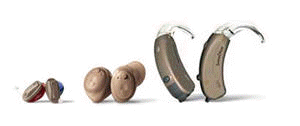06 Feb Part 4 of the Evolution of a Hearing Aid
 In the previous parts of the series, we discovered how the hearing aid industry moved from acoustic amplifiers to electric amplifiers. However, all of these hearing aids still just simply turned sounds up louder so the hearing impaired individual would get an overall louder signal.
In the previous parts of the series, we discovered how the hearing aid industry moved from acoustic amplifiers to electric amplifiers. However, all of these hearing aids still just simply turned sounds up louder so the hearing impaired individual would get an overall louder signal.
In the 1960s, Bell Laboratories started working on a process to analyze speech and audio signals on a computer. Later in the 1970s, the microprocessor was invented, opening the door for the miniaturization of the hearing aid. Also, a researcher named Edgar Villchur developed amplitude compression, allowing the computer to adjust certain frequencies independent of the other frequencies. Rather than just turning all sounds up, amplitude compression allowed the computer to choose which sounds to turn up based on the individual’s hearing loss. As computer chip technology continued to move forward, this allowed for advances in digital hearing aids. At this point, hearing aids became minicomputers that processed the audio signal in real time. However, many of these hearing aids were still body-worn, with wires that fed the sound into the ear.
In 1989, the first behind-the-ear digital hearing aid was launched. This was a major milestone as it allowed hearing aid users to free themselves from the wires associated previously with hearing aids.
The next big step was the first all-digital hearing aid; while Oticon developed the first digital hearing aid in 1995, it was only provided to research centers and did not hit the market. The first commerically available all digital hearing aid was the Senso, a hearing aid created by Widex in 1996 (top right picture). After that, Oticon presented their digital hearing aid called the DigiFocus.
 Today, all hearing aids use digital technology and artificial intelligence. Not only are the hearing aids discreet, but they are low maintenance and very “smart” devices. Once programmed by a healthcare professional to suit your specific hearing needs (it is not one size fits all!), hearing aids adjust automatically to your environment and adapt in background noise. They can also connect using bluetooth technology to devices such as cellphones, televisions, iPads, etc, allowing the hearing aid user to listen hands free or headset free through their hearing aids.
Today, all hearing aids use digital technology and artificial intelligence. Not only are the hearing aids discreet, but they are low maintenance and very “smart” devices. Once programmed by a healthcare professional to suit your specific hearing needs (it is not one size fits all!), hearing aids adjust automatically to your environment and adapt in background noise. They can also connect using bluetooth technology to devices such as cellphones, televisions, iPads, etc, allowing the hearing aid user to listen hands free or headset free through their hearing aids.
We’ve come a long way from ear trumpets to fully digital hearing aids with wireless compatibility, don’t you agree?


